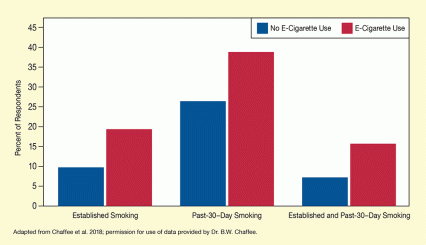In this research:
- A study linked adolescents' use of e-cigarettes to higher odds of progressing from experimental to established use of combustible cigarettes.
- A second study found that adult smokers who used e-cigarettes were less likely to have stopped smoking than adult smokers who did not use e-cigarettes.
E-cigarettes are not an effective tool to reduce combustible-cigarette smoking, two NIDA-supported studies indicate. One study showed a positive association between e-cigarette vaping and progression to established cigarette smoking among adolescents. The other found a negative association with successful smoking cessation among adults.
Both studies were conducted at the University of California, San Francisco, Center for Tobacco Control Research and Education. In the first, Dr. Benjamin W. Chaffee, Dr. Stanton A. Glantz, and Dr. Shannon Watkins analyzed data provided by 1,295 boys and girls who participated in the nationally representative Population Assessment of Tobacco and Health (PATH) study. When first interviewed in 2013-2014, all the teens had experimented with combustible cigarettes (i.e., had smoked 1 to 99 cigarettes in their lifetime) but were not yet established smokers (i.e., had not smoked 100 or more cigarettes in their lifetime). Nearly half had vaped. At follow-up interviews a year later, the teens who had reported using e-cigarettes in their first interview were, compared to those who had not:
- About twice as likely to have become established smokers
- 1.5 to 2 times more likely to have smoked during the past 30 days (see Figure).
Dr. Chaffee says, "Not every adolescent who experiments with e-cigarettes will go on to smoke, and some who do go on to smoke might have done so regardless. However, convincing evidence shows that e-cigarette use substantially increases the odds of becoming an established smoker—even for youth who have an otherwise low risk for cigarette smoking."
In the second study, Dr. Margarete C. Kulik, Dr. Glantz and Dr. Nadra Lisha analyzed data from a 2014 survey of adults in 28 European countries. More than 12,500 adults with histories of smoking combustible cigarettes reported whether (1) they had ever used a tobacco-containing e-cigarette and (2) they still smoked combustibles or had quit. The analysis revealed that those who had used an e-cigarette were nearly two-thirds more likely to still be smoking combustibles than those who had not. Moreover, they smoked more combustible cigarettes per day (average 15.6 vs. 14.4 cigarettes per day).
Dr. Heather Kimmel of NIDA’s Epidemiology Research Branch comments, "E-cigarettes may serve to re-normalize the use of combustible cigarettes, decreasing the motivation to quit."
"The evidence clearly shows that e-cigarettes do not help smokers cease tobacco use and are expanding the tobacco epidemic by attracting low-risk youth, many of whom advance to conventional cigarettes,” says Dr. Glantz. "'Harm reduction,' the fundamental assumption used to justify e-cigarettes, is wrong."
Both Dr. Chaffee and Dr. Glantz recommend prevention efforts to emphasize that e-cigarettes are not "harmless water vapor" and that long-term health risks are not yet known. They further suggest that policies regarding minimum age, indoor air laws, youth-oriented marketing, and taxes for e-cigarettes should mirror those for traditional cigarettes.
These studies were supported by NIH grant DA043950.
- Text Description of Figure
-
The bar chart shows the smoking habits of adolescents who had already been experimenting with conventional cigarettes 1 year earlier. Blue bars indicate those respondents who had never used e-cigarettes and red bars indicate respondents who reported having ever used e-cigarettes. The horizontal x-axis indicates the three smoking habits assessed: established smoking (having smoked 100 or more cigarettes) (left), past-30–day smoking (middle), and established and past 30–day smoking (right). The vertical y-axis shows the percentage of respondents from 0 to 45 percent. Established smoking was reported by about 10 percent of those who had never smoked e-cigarettes and about 19 percent of those who had ever smoked e-cigarettes. Past 30–day smoking was reported by about 27 percent of those who had never smoked e-cigarettes and about 39 percent of those who had ever smoked e-cigarettes. Established and past 30–day smoking was reported by about 7 percent of those who had never smoked e-cigarettes and about 16 percent of those who had ever smoked e-cigarettes.
Sources:
- Chaffee, B.W., Watkins, S.L., and Glantz, S.A. Electronic cigarette use and progression from experimentation to established smoking. Pediatrics 141(4):e20173594, 2018.
- Kulik, M.C., Lisha, N.E., and Glantz, S.A. E-cigarettes associated with depressed smoking cessation: A cross-sectional study of 28 European Union countries. American Journal of Preventive Medicine 54(4):603-609, 2018.

